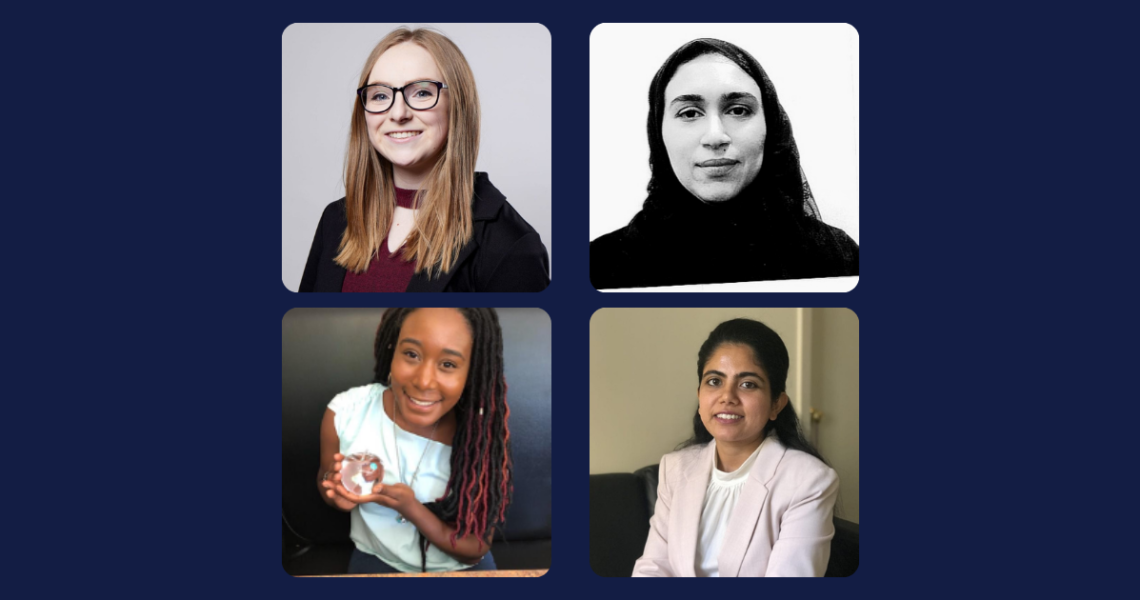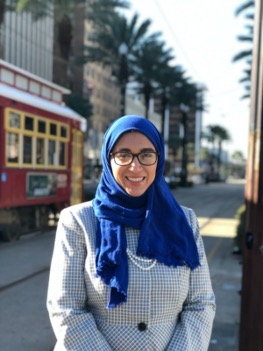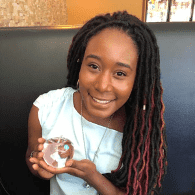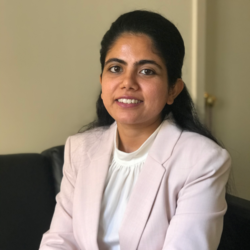
Reflecting on a Year as a Remote Design Thinking Graduate Assistant
The academic year 2020 – 2021 was an interesting challenge and experiment in working and building community remotely. The Taylor Center’s 2020-2021 Graduate Assistants in Design Thinking for Social Impact learned many pros and cons of working remotely and running remote workshops. The variety of backgrounds of the Design Thinking Graduate Assistants shows how different fields can work together, the value of learning how to use design thinking in different fields, and how design uses different fields. What information will they use in the future? And what are their big plans for the future? Read on to find out!

Shaymaa Abdalal, MBBS, MHTM
Who would imagine that 2020 would be the year that they canceled school, and I rolled on a mask to engage virtually with people all over the world from my tiny home office with four children running around? This was the year that I embraced pluriversality and practiced AND thinking. Although I began my involvement with the Taylor Center back in 2018 when I attended the Changemaker Institute, my curiosity and love of learning keep bringing me back: starting as an attendee of DT Donuts to being a coach leading a team in the in Fast 48. COVID-19 dramatically changed my plan. As a public health professional, I knew how bad this would be and worse the unbearable uncertainty. How could I navigate this gloomy dark future?
After having the pleasure of working with Dr. Lesley-Ann Noel throughout the lockdown in Pass Dat Joy, I realized the powerful impact of mentorship. It was the perfect time for me to join the Design Thinking for Social Impact Team. As I learned about Design Thinking, I experimented and became equipped with social innovation tools. It was time to learn how to apply these skills. It was an exciting time. I learned how to see setbacks as signs of progress, called failure challenge. The most rewarding part was accepting and connecting with my superpowers ( ADHD, Dyslexia, and dysgraphia). I am not less than or challenged. I am just different. If barriers are removed, I will be able to fly.
Through the nurturing mentorship of Dr. Noel and her patience, I was able to shine. Using all these interactive, collaborative design tools turned out to be a powerful way to keep me focused and productive. Taking all the frustration, anger, and feeling of injustice and turning it into something powerful and helpful was the best advice ever. I believe that I will carry with me the Taylor Center’s core values (respect, connection, creativity, and learning) with me wherever I Roll.

Niesha Ford
This year was a year of learning for me. It was my first time understanding what design thinking was, although I have seen and implemented it in my life before without using those specific words. As a part of the learning process, I gained hands-on facilitation experience in design thinking. Those experiences included leading two workshops on a design thinking method and co-facilitating eight workshops. All of these workshops were remote. In the end, I can say I have learned more than I would have imagined going into this job about design thinking and leading remote workshops.
One thing I really enjoyed about being a facilitator in these workshops is the ability to meet people all over the world. When people introduce themselves and say they are tuning in from someplace miles away, in a whole different country, it really shows how limited in-person-only workshops and meetings can be. If being in a pandemic has taught many of us anything, we live in an interconnected world. I think online workshops really embrace the idea of information and education truly being open for everyone.
This brings me to another thing I have learned while being a remote GA. Design thinking methods are diverse. As someone learning about public health during a pandemic, I have been pleasantly surprised about how much I can incorporate design thinking principles into my school work, research, and community outreach. Although the idea of design thinking feels limited to its name- designers, maybe engineers- really anyone can be a designer in their field of interest or expertise.
In the future, I hope to work in community outreach and program planning. In this role, I think design thinking could be useful in this area to run small pilot programs to see how people use the program and make changes as necessary before using it in a bigger community.

Sneha Rout
I joined Taylor Center with an interest in social innovation and realized design thinking has been inadvertently used by me earlier. This year-long experience for me has been a combination of using both these components in research. As a public health nutritionist, I have been trying to redefine problems around child malnutrition and create innovative solutions for long-term behavioral change. Here, I was able to re-examine my approach towards cognitive methods using a systematic design thinking framework. One of the best ways to learn about design thinking was through self-observation of user’s needs, analyzing the problem one wants to deal with, and then building their own set of skill-sets to reach desired outcomes.
From my public health field experiences, even after knowing five languages, I find communication can be challenging when imparting knowledge and reciprocating for many people involved in studies. So my goal was to find ways to integrate design thinking as a method that can help people with self-expression and identify health or nutrition behavior-specific challenges. I used poetry, storytelling, and narratives as tools to capture people’s experiences during COVID-19 through the two design thinking workshops facilitated. Working remotely especially developing virtual workshops and coordinating with the teams online was daunting but we were able to overcome those barriers within our timelines. As someone who is old-school and preferred paper-pen for notetaking, I learned to use digital tools like Mural for my workshop activities.
For me, design thinking is a creative way of problem-solving with a logical application of any approach that the designer wants to convey to his/her audience. It was harder said than done. A lot of background preparation and effort with our supervisor was required for all these workshops and publications. Networking in pandemic has been difficult, but gladly I was motivated by the participants who attended these workshops and interactions with others who reached out post-workshops to learn more. Another area of my involvement was in pre-event social media promotion for Design Thinking Gumbo and Design Thinking Breakfast, which made me learn the programmatic aspect of putting events together to gain better visibility. Overall, this experience has been a great utilization of time and learning, making acquaintances with wonderful colleagues, speakers, and participants from all over the world.

Natalie Hudanick, MPH
This year has been a year of developing new skills and ways of thinking. I hadn’t heard of design thinking before starting my time as a graduate assistant with the Taylor Center. Still, looking back on the last few years in my undergraduate education, I was informally using design thinking all the time, especially in my anthropology classes. This position has also helped me understand how I can use design thinking in public health. Design thinking can bring so much more to public health, especially program design and planning, needs assessment, evaluation, or any qualitative research. I plan to use this throughout my public health career because the design thinking process can easily be translated to almost any field, especially fields that involve working with people (like public health).
As a GA this year I have been able to build on my understanding of design thinking and to build skills for virtual workshops and projects. This year I have remotely created and facilitated one workshop on virtual ethnography, facilitated another workshop on rapport building, collaborated on a virtual brainstorming workshop, and was a part of a team creating a publication and podcast on design thinking. These projects all have provided me with various skills, especially the workshops. I have never created workshops before, let alone virtual ones, and to be able to do that is has been one of my favorite, though stressful, experiences. The podcast and design publication has been a process, but I’m glad to have been working on this project as I have learned from many different designers on their views of design.
Adjusting to being remote for the entire year has been challenging but rewarding. While I miss being in an office-type environment where I can meet with people easily, ask questions, or even just chat, adapting to being remote is a skill in itself. This group of GAs and our supervisor have continually worked to build rapport with each other so that working together is not awkward or filled with silences. We have come to be supportive of each other’s projects and accomplishments within this position, and that has been one of my favorite things of being a remote GA. This year has been a challenge for everyone, but being able to gain new skills, new friends, and new understandings of design thinking have been some of the best outcomes of this graduate assistant position. I’ll forever be grateful for the opportunities and experiences that this position has created.